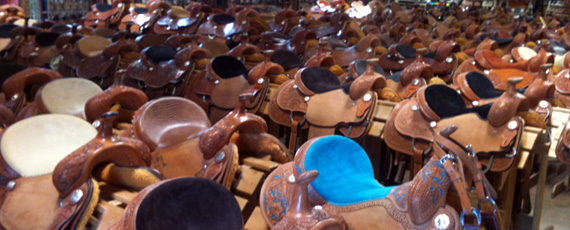Not long ago, I was having a think about the reasons that people buy saddles that so obviously don’t fit their horses. This is a regular spell of head-scratching that occurs when I’ve worked on a few horses with back and postural issues stemming from saddle misfit.
Now, in my view, a saddle fit session is a pretty critical part of buying a saddle.
It goes without saying, surely, that there’s a living, breathing horse out there in the paddock or stable and that the new saddle needs to fit onto his back – and that this suitability really does need to be established before the saddle is purchased.
Yet, many people still buy a saddle and only afterwards try to establish whether it will fit their horse or not.
It’s all a bit of a gamble – not only with their money, but with their horses’ comfort and back health.
All text (c) Jane Clothier, https://thehorsesback.com No reproduction without permission. Thanks!
What on earth is going on here?
Good question. Either people are genuinely unaware of the reasons for fitting saddles, or they do know but are marching to a different, louder drumbeat when they go shopping.
To make more sense of this, I decided to apply the psychology of consumer buying behavior. At the simplest level, there are five stages involved in a purchase:
- Need recognition (we feel the need for a new saddle),
- Product research (we learn what’s out there),
- Evaluation (we consider everything learned through our research),
- Purchase decision (we carefully select the most suitable saddle), and
- Post-purchase behavior (we react positively or negatively to our choice).
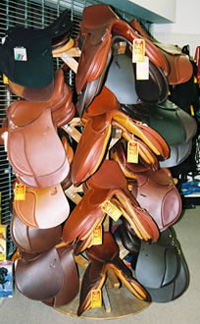 Well, how tidy is that? Too tidy, maybe. The problem is that we all behave erratically when shopping, being influenced by our personal biases.
Well, how tidy is that? Too tidy, maybe. The problem is that we all behave erratically when shopping, being influenced by our personal biases.
These are preferences, beliefs and thought processes that hold up our personal view of the world – and our illusions. Biased behavior includes:
- Cherry-picking information by being selective over what we see, hear and read,
- Yielding to peer pressure,
- Favoring someone’s viewpoint because we like them (whether we know them or not – take celebrity endorsement),
- Supporting our self-image (actually how we think other people see us),and
- Being totally inconsistent in our behavior, just because we do that.
We’re none of us exempt from this. Being emotionally charged, biases are very motivating.
What happens is that they can leapfrog us from need recognition straight to purchase decision, making us ignore the research and evaluation findings or leave them out altogether. (And this forms the basis of every advert you’re ever likely to look at.)
10 Emotional Saddle-buying Decisions
Here are 10 ways that you can succumb to biases that skew your saddle purchase decisions.
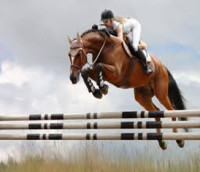
1. Your instructor or trainer uses that saddle
Whoah… this could cause some shouting, but instructors, trainers and clinicians don’t always know all there is to know about saddle fit, even though they know HUGE amounts about riding and training.
No offence meant, honestly, but some riding instructors give their students terrible advice about saddles. They say one fits, when it doesn’t. Horse owners just follow this well-meant advice, because they really believe in and admire their instructor.
Some trainers and clinicians even use a favorite saddle on all their own and their clients’ horses. It suits the rider, so… Some of these cause damage and the clients often don’t realise until someone else points it out at a later date.
(There’s a variation on this one, too: attend clinic or do course, then buy saddle. No further comment.)
2. Your knowledgeable friend owns that saddle
A lot of horse-related knowledge is passed between friends. When it’s good, it’s good, but when it’s bad, it can be very bad.
No matter how much you like your friend, there’s a high chance that their physique and their horse’s is likely to be different to yours. And your friend will very likely ride differently too. These three points are frequently overlooked.
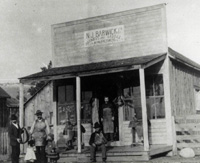
3. There’s a local saddle maker in town who makes that saddle
He lives close by and tells the local horse community all about what he does and what he makes. He’s knowledgeable, he loves his work and, dang it, he’s such a nice guy.
It’s possible, just possible, that he may know more about producing beautiful hand-crafted saddles than equine anatomy and biomechanics, having learned more from his father and other craftsmen than from modern schools of equine thought.
And, obvious as it sounds, there’s a difference between a saddle-maker and a saddle-fitter, although there are definitely plenty of saddle-makers who are also great saddle-fitters.
But at small town level it can, and does, go either way. (You can probably tell I’m trying not to offend anyone here.)
Can the buyer tell the difference? Frequently not, as so many people buy an expensive, custom-made saddle that doesn’t fit, but which can’t then be returned. (If this isn’t the case with your locally made saddle, then brilliant – I’m genuinely pleased for you.)
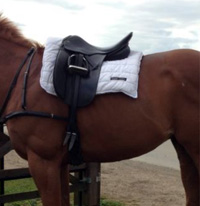
4. That saddle is named after a famous rider
There are many saddles out there named after a top-of-their-game rider – it’s celebrity endorsement with bells on.
It’s a funny thing how what works for them makes that style of saddle suitable for hundreds of thousands of other riders and their horses, of all shapes and sizes.
And the buyer’s riding will improve to an unfathomable degree… won’t it?
Aspirational shopping aside, some of these saddles are amazingly good, but (no naming names now) not all of them are. This is particularly true if they’re occupying what we can call the ‘value end’ of the market.
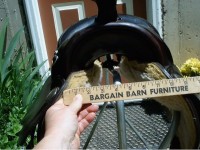
5. Your friend with the same breed of horse as you has that saddle
Some people constantly draw parallels between their own horse and that of a friend or acquaintance who has a horse of the same breed.
The prospective saddle buyer sees which saddle their friend has and decides it must be good for their horse too.
This is so much the stronger if the owner is much admired or is winning in competition with that saddle.
Yes, breeds obviously have prevalent conformational traits. But it’s not a given, as horses – and their riders – can be very individual.

6. You’ve seen a stunning photo of that saddle in a magazine
And it really was beautiful. The horse was beautiful, the saddle was beautiful, and the rider was stunningly beautiful. An image of dreamlike perfection… in an advert. It always works, doesn’t it?
We’ll all look just like the stunner in the paradise-like photo once you buy the saddle.
No, I don’t think so either.
7. A Facebook regular recommends that saddle
We all know them and recognize them: the person who is very vocal on Facebook, being big in their own lunchtime with strongly held opinions. A queen bee, they hold forth at the center of a community of regulars who mutually reinforce one anothers views.
To the less informed reader, this verbiage may sound like unassailable fact. So when the queen bee says a certain saddle is the best and how it’s right for certain horses, her view may be perceived as being expert opinion.
(Hey, she may indeed be right, but not above and beyond someone who is standing look and assessing fit on actual, living horse – with a rider on board.)
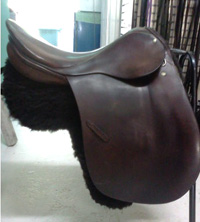
8. When you were a kid, everyone craved that saddle
Times change, the knowledge-base grows and designs evolve. The industry moves on (although some companies don’t) and what was great back then may not be so now.
Brand names rely on consumer loyalty, but over long periods of time your loyalty may be misplaced. Formerly great brands may now be merely good, which is OK if the price reflects that change, but…
Have you noticed that people will buy used, 25-year-old spine-pinchers just because they were made by that company?
9. Your horse went better when you tried out that saddle
What? Surely this one’s a no-brainer? You’ve borrowed a saddle and your horse went better in it than in your old saddle, which was causing problems – that means the borrowed saddle is a good fit, doesn’t it?
Nope. It’s a sure-fire indicator that your horse is showing relief at not experiencing the same old pokes and pressure points when ridden, because at last somebody has taken the offending piece of leatherwork off his or her back.
What we aren’t seeing at this stage are the new problems that may emerge from this replacement saddle that may not fit, but in a different way.
It’s like repetitive strain injury – it can take time for signs of problems to become visible (although in endurance riding, problems can show up within a single day’s ride.)
10. You’ve never seen a better price attached to that saddle
In an online world, we’ve never been more able to shop around for that super-bargain.
And when we find it, it’s all so much easier to ignore any possible shortcomings. This is even more so when time pressure is involved, for instance in an online auction.
 Try to bring in reason over emotion
Try to bring in reason over emotion
Oh I know, it’s hard to do. We’re never going to escape the emotional side of shopping, particularly with new – or new to us – saddles.
The bigger the purchase, the more rewarding it’s likely to be.
Yet that’s all about us. Our horses are happily unaware of the thrill of shopping. To the horse, a saddle that fits will minimize the negative effects of bearing our weight on its back – while one that doesn’t fit won’t.
We owe it to our horses to make informed and well-considered decisions.
I realize that it can be hard to know if you’ve got a good saddle fitter, but involving a trained professional in the research and evaluation stage of your buying decision will certainly decrease the chances of making a catastrophic error that will cause pain and damage to your horse.
Alternatively, in this online world where you can find those superb saddle bargains, hop onto YouTube and take look at some of the excellent videos posted by professional saddlers. It really couldn’t be much easier.
Questions, thoughts or comments? Join us at The Horse’s Back Facebook group.
